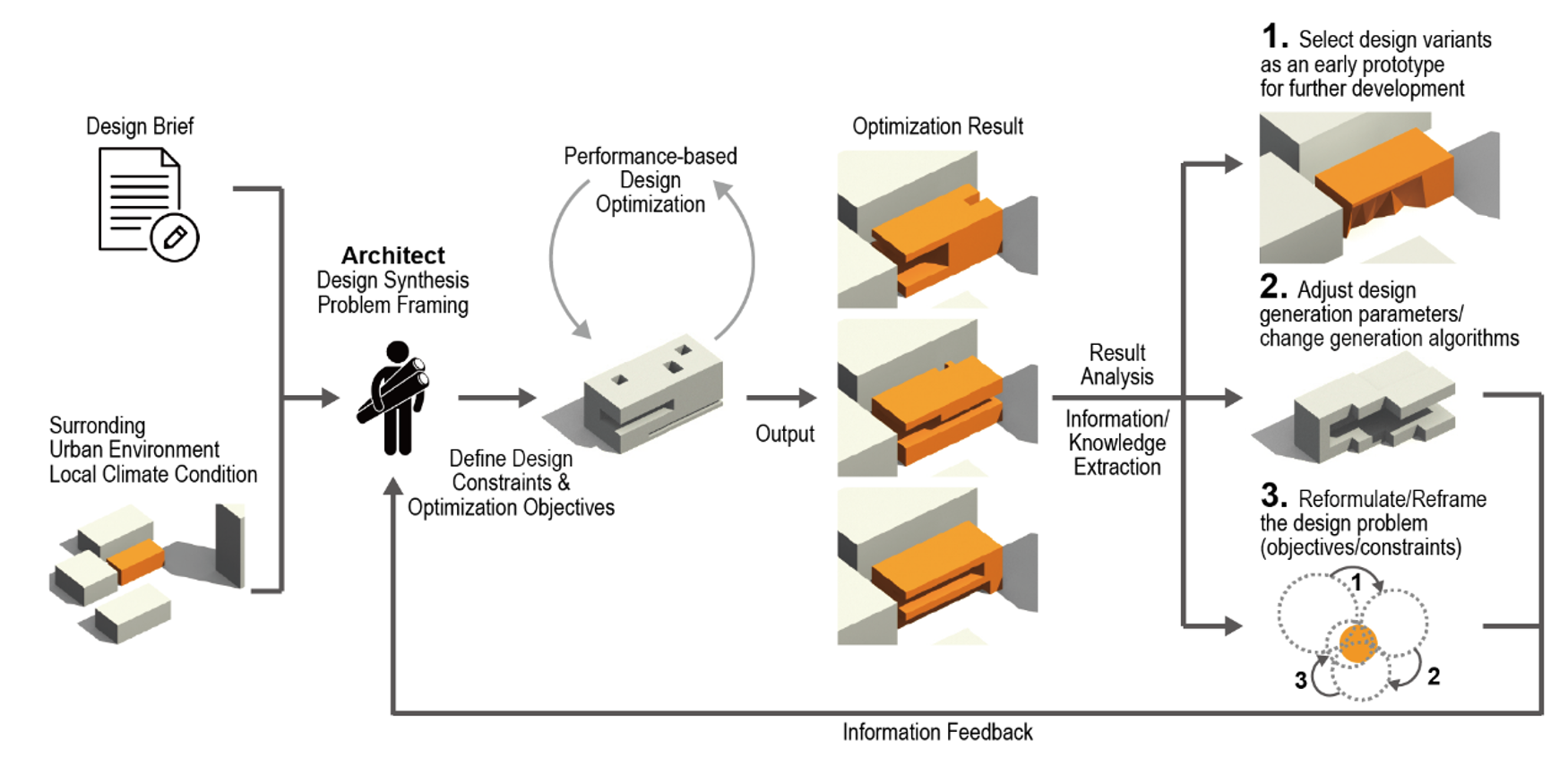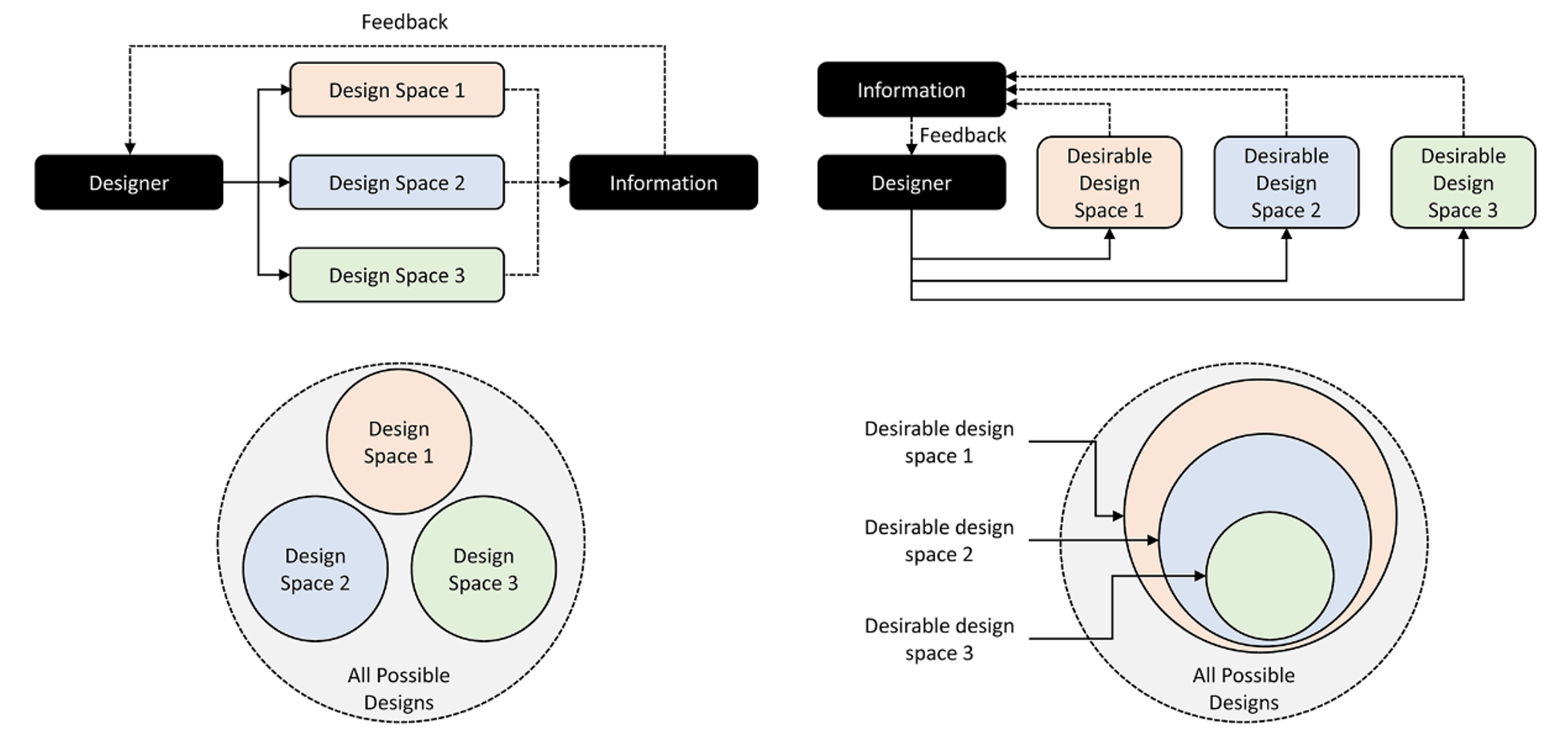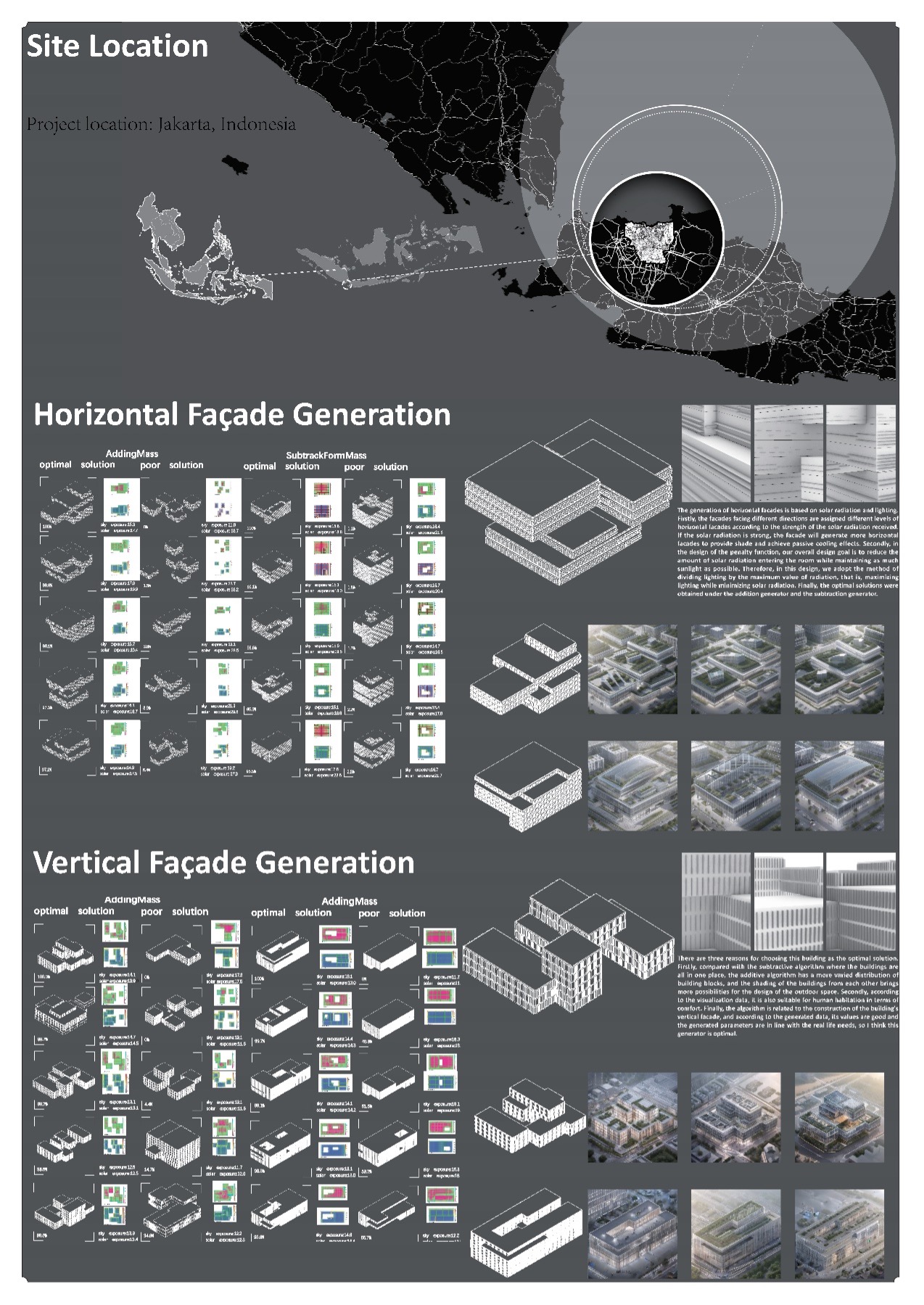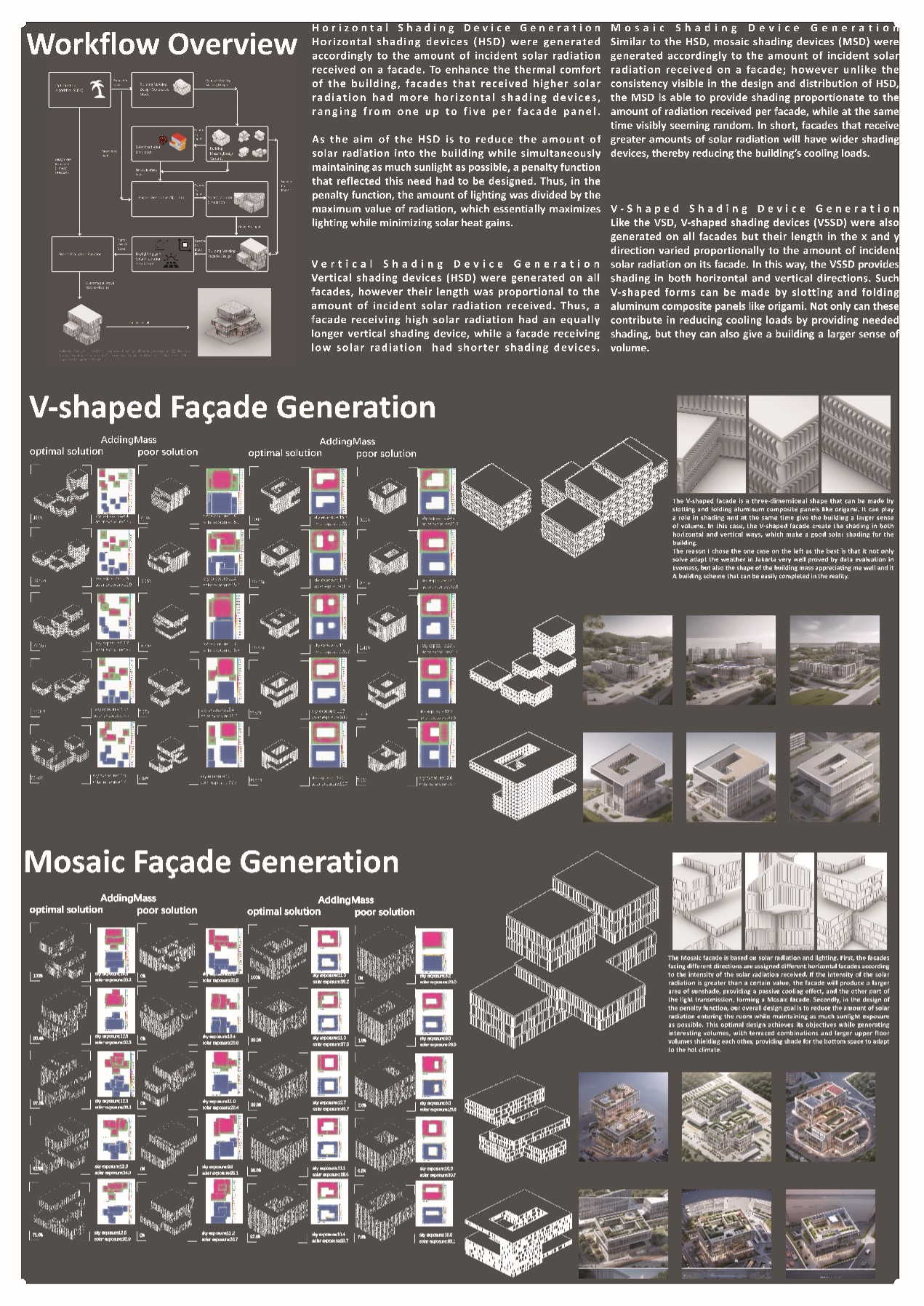Abstract
This article introduces a two-week teaching experiment conducted at XJTLU, focusing on integrating evolutionary optimization into architectural design pedagogy. The teaching leveraged a design tool called EvoMass for rapid building design optimization and exploration, allowing students to conduct evolutionary optimization without requiring advanced programming skills. Parametric modeling and generative AI techniques were also included to help students integrate building façades into optimization and exploration. The outcome of the teaching experiment demonstrates how students can apply the acquired knowledge to a performance-driven building design project, as well as how they can incorporate computational and intelligent design techniques into their creative design process.
Introduction
Evolutionary optimization is widely acknowledged as an efficient and effective approach to facilitate the digital and intelligent transition of architectural design. It is commonly utilized in sustainable and environmental building design, integrating various building performance factors, such as daylighting and solar exposure, to achieve performance-driven design optimization. This approach not only aids in optimizing design performance but also supports data collection and informed decision-making during the design process. In architectural education, evolutionary optimization has been incorporated into studio teaching across numerous universities to integrate environmental performance into the development of architectural designs (Vazquez, 2023). Previous examples have shown that the introduction of evolutionary optimization can help students identify high-performance solutions while integrating environmental and energy considerations into their projects (Pasternak & Kwieciński, 2015; Szentesi-nejur et al., 2021).
In conventional teaching activities, the instruction of evolutionary optimization tends to emphasize technical expertise, as many architectural students have limited knowledge of computational skills like programming, genetic algorithms, and parametric modeling. However, these educational efforts often fail to address the difficulty of integrating computational and intelligent design into the real-world architectural design process, particularly for the effective application of numerical convergent methods in diverse design exploration (Wang, 2022a). At XJTLU, senior-year modules offer courses related to computational design, but these mainly concentrate on engineering aspects associated with façade design rather than early-stage architectural design tasks. To address these challenges, a teaching experiment was conducted in the first semester of AY2324 in the year-three architecture program to provide students with opportunities to learn evolutionary optimization and apply it to a mini-design project. This article elaborates on the pedagogical development and methodologies used in this teaching experiment, as well as showcasing students’ design work to demonstrate the effectiveness of the teaching of this experiment.
Overview of Relevant Research and Practices
The incorporation of evolutionary optimization into architectural design education has been noted since the 2000s. Initially, the focus of teaching was on developing technical proficiency due to students' limited digital literacy and the lack of user-friendly design tools (Gerber & Flager, 2011; Pasternak & Kwieciński, 2015; Turrin et al., 2011). Early instructions often centered on using evolutionary optimization for relatively straightforward and specific design tasks tailored for student use, given the technical complexity involved. However, these tasks did not encompass the intricate, dynamic, and ambiguous nature of real-world design scenarios. Consequently, students were only able to apply their skills to solve simplified design problems, which did not seamlessly integrate into the real design process.
Over the last decade, advancements in computational and intelligent design tools, such as visual programming and more accessible optimization and simulation tools, have accelerated the integration of evolutionary optimization into architectural education. User-friendly design tools have enabled a greater emphasis on incorporating evolutionary optimization into the architectural design process. For instance, Szentesi-nejur et al. (2021) implemented evolutionary optimization in a year-three studio module to help students maximize solar potential through architectural design using computational and evolutionary optimization techniques, while Chen et al. (2019) created Py4design, a Python library for shape variation analysis, which was used in a two-week workshop at Singapore Polytechnic to allow students to explore diverse building forms and understand their performance implications.
In contrast to the early teaching examples, the recent applications of evolutionary optimization in architectural education place a stronger emphasis on enabling students to utilize evolutionary optimization tools for generating and exploring design solutions with desirable performance attributes. Moreover, the reduced technical complexity also allows students to actively participate in the design process by employing evolutionary optimization (Vazquez, 2023). While this approach effectively integrates evolutionary optimization into more realistic architectural problems, it primarily prioritizes achieving final solutions rather than assisting students in terms of design exploration and synthesis during the entire design process. In other words, evolutionary optimization is predominantly involved in the later stages of architectural design, where building form and typology are largely determined. Consequently, its role lies mainly in refining and fine-tuning predetermined typologies (Tan & Ying, 2023; Zhang et al., 2023). However, it is also widely accepted that early intervention of more systemic design exploration has a greater impact on the subsequent design process and can effectively reduce the time and effort for design amendment and modification.
One of the primary factors contributing to the aforementioned issue is the design tool employed in pedagogical activities. The behavior of designers can be significantly influenced by the design tools they utilize during their creative process (Saadi & Yang, 2023). As evolutionary optimization is derived from numerical optimization that primarily focuses on solving well-defined problems, its direct application in architectural design, which is often characterized as ill-defined and open-ended, may prove infeasible (Cross, 2021). Consequently, instructors frequently need to transform an ill-defined architectural design problem into a well-defined one to enable students to employ evolutionary optimization. This also accounts for why many students find it challenging to apply their acquired skills and knowledge in their own designs (Agirbas, 2020).
In order to recalibrate the application of evolutionary optimization in architectural design, the author has developed EvoMass(Wang et al., 2024; 王力凯 et al., 2022), a computational and intelligent design tool specifically designed for early-stage building massing design generation and optimization. This tool effectively addresses the linearity and convergence limitations inherent in conventional evolutionary optimization tools by enhancing both design diversity and information conveyance within the optimization results (Wang et al., 2024).
EvoMass comprises two generative models for building massing design, utilizing principles from additive and subtractive form generation. These models are capable of producing designs that embody diverse building massing typologies. Unlike conventional evolutionary optimization, which often fixates on a specific design typology, these models transcend such limitations, thereby expanding the solution space for optimization search. Furthermore, EvoMass incorporates a hybrid evolutionary algorithm (SSIEA) that integrates a steady-state replacement strategy and an island-based approach. This algorithm serves as the driving force behind the optimization process (Wang et al., 2020), enhancing both the efficiency of the optimization process and the diversity of the optimization results. The synergy of the design generative models and SSIEA enables EvoMass to be effectively deployed across various design scenarios, equipping designers with valuable insights into the relationship between building performance and design typologies.
Methodology
This teaching experiment aims to investigate the integration of evolutionary optimization into architectural design pedagogy within the XJTLU context, enabling students to utilize it in their design exploration, ideation, and synthesis. Therefore, the presented teaching experiment centers around the research question of how to facilitate students' utilization of evolutionary optimization in their design process and its impact on students' modes of thinking and behavior. To address this question, the teaching experiment is conducted by incorporating EvoMass along with a corresponding teaching method that guides students in conducting performance-driven design optimization and exploration.
The teaching experiment comprises a two-week workshop that incorporates technical tutorials and hands-on sessions, enabling students to apply the knowledge and skills acquired from these tutorials to a conceptual architectural design project. This teaching experiment builds upon a pilot study conducted in the ARC205 design studio module, which assesses students' proficiency in computational and intelligent design and their overall approach to design. As a result, unlike previous teaching activities involving EvoMass, this teaching experiment allows for a more extensive and continuous intervention among the students involved in this project, facilitating long-term observation of the impact of incorporating EvoMass into architectural education on skill development and fostering a more exploratory mode of design thinking.
Teaching Approach
As highlighted in the literature review, design tools play a crucial role in the pedagogy of evolutionary optimization in architecture. Existing tools often tend to direct teaching towards a linear and convergent process focused on achieving optimal solutions. Simultaneously, the technical demands associated with learning skills for programming and coding can divert the focus of teaching towards technical know-how rather than its application in design. Therefore, this teaching experiment employed EvoMass as an aid for students to engage in design optimization and exploration within the realm of computational design (Figure 1). First, as mentioned earlier, EvoMass serves as an integrated design tool that enables students with limited computational expertise to conduct optimization without requiring advanced programming or scripting skills. Second, EvoMass aims to provide abstract building massing designs that reveal rich design implications related to building performance and environmental considerations. Consequently, utilizing EvoMass encourages students to extract valuable information and insights from optimization results and integrate them into their overall design process. In other words, it is not recommended for students to directly adopt designs generated by EvoMass as final solutions.

Figure 1. Design workflow of EvoMass
In addition to utilizing EvoMass, a related design methodology facilitating parallel design exploration was also incorporated into this teaching experiment (Wang, 2022b) (Figure 2). As most participating students involved in this experiment had prior experience using EvoMass, the workshop primarily aimed at instructing students on employing EvoMass for conducting parallel design exploration while encompassing building formal characteristics, subjective design intent, and building façade patterns. This approach enabled them to gain a better understanding of how to utilize EvoMass across various design scenarios and objectives.

Figure 2. Two different design approaches using EvoMass in early-stage architectural design exploration
Furthermore, the workshop incorporated Generative AI as an additional component. Due to EvoMass’ limitation in generating abstract building massing designs, it cannot provide details regarding architectural styles and façade languages. To address this limitation, recent advancements in Generative AI and associated tools like Midjourney and Stable Diffusion can be utilized to rapidly generate design images that encompass rich information about architectural styles and façade languages based on the abstract designs produced by EvoMass. At the same time, using optimized design produced from performance-based design optimization allows this approach to resolve the issue of lacking contextualization when solely relying on Generative AI in architectural design. Consequently, one tutorial during the workshop was dedicated to instructing students on combining EvoMass with Generative AI, which was delivered by a Ph.D. student from the architectural department.
Finally, upon completion of all tutorials, the participating students were instructed to apply the acquired skills and design methods in a mini-design project. Due to time constraints, the six participants were grouped together to collaborate on a building design situated in Indonesia. This collaborative effort allowed them to explore different design directions in parallel within the project, facilitating an understanding of how design exploration can foster parallel thinking while avoiding fixation. In this mini-design project, each student developed a façade generation algorithm based on distinct patterns capable of generating building facades derived from EvoMass-generated designs. Subsequently, an optimization process was employed to evolve the population of designs towards high-performance solutions. In the second stage, students utilized Generative AI for further architectural feasibility assessment of optimized designs obtained in the first stage.
Results
Following one week of optimization and utilizing Generative AI for design exploration, the students undertook a comprehensive performance-based design exploration of building massing and façades. Through this process, the students created four distinct building façade patterns and, using each of them, conducted performance-based design optimization aimed at reducing solar heat gain while improving indoor daylight accessibility. The students then categorized the solutions based on their performance metrics, allowing them to discern the adaptability of the building massing forms and façade patterns in addressing the aforementioned conflicting performance objectives.

Figure 3. Final design poster-1

Figure 4. Final design poster-2
During the design exploration process aided by optimization, the students utilized both subtractive and additive building generative models in EvoMass, as well as façade development algorithms. By incorporating two different design generative models, the students were able to broaden their design exploration and assess two distinct building massing form typologies within the optimization process. This allowed them to identify the strengths and weaknesses of each building massing typology in relation to their adaptability to different façade patterns. As shown on the posters, the students’ analysis revealed different tendencies associated with building massing typologies and façade patterns. For instance, when employing a V-shaped-shading or vertical-shading façade pattern, the optimized designs tended to feature a more fragmented massing form. On the other hand, when utilizing a mosaic or horizontal-shading façade pattern, the optimized designs showcased larger cantilevered blocks that improved the building's self-shading.
The completion of the performance-based design optimization was followed by the students' use of Generative AI to assess the feasibility of the optimized designs. The focus was primarily on aesthetic quality. Six selected images generated from the AI are displayed on the right-bottom side of each group of optimization results. These images enabled the students to swiftly explore diverse ideas related to architectural style and languages. Notably, given the strong connection between the input building geometry and environmental context as well as building performance, this exploration also integrated environmental considerations into the AI generative process. The aim of this exploration was to assist students in quickly identifying a design direction with greater potential for further development.
This step is significantly helpful for students because, due to their lack of design expertise, students are often overwhelmed by a large number of design options when using evolutionary optimization. In many cases, students have to spend a lot of time evaluating or manually developing a certain number of design options before they can choose an appropriate one. As a result, the use of Generative AI can accelerate and improve the process of assessing the potential of optimized designs, as infeasible design options can be quickly excluded.
Discussion and Conclusion
The teaching experiment presented here investigates the integration of evolutionary optimization into architectural design education at XJTLU. This experiment is the second phase of a longer study focused on using evolutionary optimization for architectural instruction. Based on students' work, it is clear that the teaching experiment has largely met expectations, enabling students to develop a deeper understanding of how evolutionary optimization can be applied in architectural practice. This project advances the pedagogy of computational and intelligent design in architecture in two major aspects.
First, this experiment demonstrates that employing the proposed teaching method, which does not require advanced programming or parametric design skills, effectively facilitates students' initiation of computational and intelligent design applications in their own work. This avoids the frustration that is often observed in similar technical teaching activities (Agirbas, 2020, 2021). Second, by emphasizing the utilization of evolutionary optimization within the architectural design process, this teaching experiment also equips students with valuable hands-on experiences and strategies beyond technical design skills, including aspects such as design exploration and parallel thinking. This facilitates the students to understand “why” they should use this technique in their design before learning “how” to use it, and the practical relevance and applicability of computational and intelligent techniques are also challenging to emphasize in common teaching approaches (Agirbas, 2021; Vazquez, 2023).
In conclusion, this study introduces a teaching experiment focusing on the integration of evolutionary optimization into architectural design teaching within the XJTLU context. The teaching experiments guide students to apply evolutionary optimization in a more intricate and dynamic exploration process. The teaching objective was effectively achieved based on the student’s work, as they not only acquired computational and intelligent design skills but also gained a broader understanding of architectural design.
References
Agirbas, A. (2021). An Experimental Framework for Designing a Parametric Design Course. Design and Technology Education: An International Journal, 26(3), 102–118.
Chen, K. W., Choo, T. S., & Norford, L. (2019). Enabling Algorithm-Assisted Architectural Design Exploration for Computational Design Novices. Computer-Aided Design & Applications, 16(2), 269–288. https://doi.org/https://doi.org/10.14733/cadaps.2019.269-288
Cross, N. (2021). Engineering Design Methods: Strategies for Product Design (5th Editio). Wiley.
Gerber, D. J., & Flager, F. (2011). Teaching Design Optioneering: A Method for Multidisciplinary Design Optimization. Computing in Civil Engineering (2011), 883–890. https://doi.org/10.1061/41182(416)109
Pasternak, A., & Kwieciński, K. (2015). High-rise Building Optimization: A Design Studio Curriculum. ECAADe 33, 1, 305–314.
Saadi, J., & Yang, M. (2023). OBSERVATIONS ON THE IMPLICATIONS OF GENERATIVE DESIGN TOOLS ON DESIGN PROCESS AND DESIGNER BEHAVIOUR. Proceedings of the Design Society, 3(JULY), 2805–2814. https://doi.org/10.1017/pds.2023.281
Szentesi-nejur, S., Luca, F. De, & Nejur, A. (2021). Integrated Architectural and Environmental Performance- Driven Form-Finding A teaching case study in Montreal. ECAADE2021, Towards a New, Configurable Architecture, 2, 105–114.
Tan, C., & Ying, D. (2023). A “Designer-centric” Framework for Building Massing optimization. Proceedings of the International Conference on Education and Research in Computer Aided Architectural Design in Europe, 2(Ml), 147–156. https://doi.org/10.52842/conf.ecaade.2023.2.147
Turrin, M., Von Buelow, P., & Stouffs, R. (2011). Design explorations of performance driven geometry in architectural design using parametric modeling and genetic algorithms. Advanced Engineering Informatics, 25(4), 656–675. https://doi.org/10.1016/j.aei.2011.07.009
Vazquez, E. (2023). Teaching parametric design: fostering algorithmic thinking through incomplete recipes. Open House International. https://doi.org/10.1108/OHI-06-2023-0135
Wang, L. (2022a). Workflow for applying optimization-based design exploration to early-stage architectural design – Case study based on EvoMass. International Journal of Architectural Computing, 20(1), 41–60. https://doi.org/10.1177/14780771221082254
Wang, L. (2022b). Optimization-aided design: two approaches for reflective exploration of design search space. International Journal of Architectural Computing, 20(4), 758–776. https://doi.org/10.1177/14780771221134958
Wang, L., Janssen, P., & Ji, G. (2020). SSIEA: a hybrid evolutionary algorithm for supporting conceptual architectural design. Artificial Intelligence for Engineering Design, Analysis and Manufacturing, 34(4), 458–476. https://doi.org/10.1017/S0890060420000281
Wang, L., Janssen, P., & Ji, G. (2024). Optimization-based design exploration of building massing typologies—EvoMass and a typology-oriented computational design optimization method for early-stage performance-based building massing design. Frontiers of Architectural Research, xxxx. https://doi.org/10.1016/j.foar.2024.06.001
Zhang, R., Xu, X., Zhai, P., Liu, K., Kong, L., & Wang, W. (2023). Agile and integrated workflow proposal for optimising energy use, solar and wind energy potential, and structural stability of high-rise buildings in early design decisions. Energy and Buildings, 300(July), 113692. https://doi.org/10.1016/j.enbuild.2023.113692
王力凯, 吉国华, 童滋雨, & 江山. (2022). 面向建筑性能的设计优化及设计探索——EvoMass工具简介. 新建筑, 84–89. https://doi.org/10.12069/j.na.202203084





